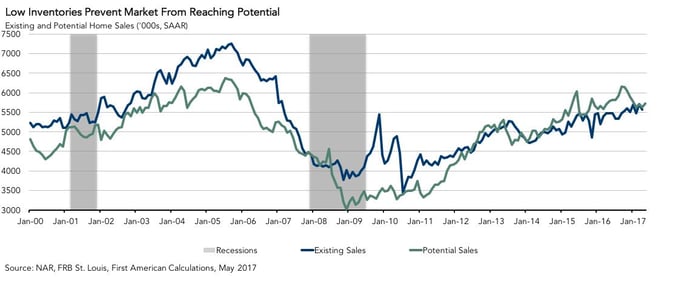First American’s proprietary Potential Home Sales model examines May 2017 data and includes analysis from First American Chief Economist Mark Fleming on how the real estate market is performing versus its potential.
May 2017 Potential Home Sales
For the month of May, First American updated its proprietary Potential Home Sales model to show that:
- Potential existing-home sales increased to a 5.72 million seasonally adjusted, annualized rate (SAAR), a 1.8 percent month-over-month increase.
- This represents a 90.3 percent increase from the market potential low point reached in December 2008.
- In May, the market potential for existing-home sales fell by 1.1 percent compared with a year ago, a decline of 62,000 (SAAR) sales.
- Currently, potential existing-home sales is 644,000 (SAAR), or 11.2 percent below the pre-recession peak of market potential, which occurred in July 2005.
Market Performance Gap
- The market for existing-home sales is underperforming its potential by 3.8 percent or an estimated 218,000 (SAAR) sales.
- Market potential grew by 1.8 percent month over month, an estimated increase of 98,000 (SAAR) sales between April 2017 and May 2017.
"As more and more Millennials marry and have children, among the strongest determinants for the desire to be a homeowner, demand for housing will remain robust."
Simple Formula: Lower Inventories + High Demand = Declining Affordability
“As more and more Millennials marry and have children, among the strongest determinants for the desire to be a homeowner, demand for housing will remain robust. However, the housing market faces a dilemma that is restricting the inventory of homes for sale,” said Mark Fleming, chief economist at First American. “As rates rise and the cost to finance a mortgage increases, existing homeowners are prisoners in their own homes. In addition, the fear of being unable to find a home to purchase hinders homeowners’ decision to sell. The low inventory of homes for sale is preventing the housing market from reaching its potential and pressuring prices higher. Increasing shortages of homes for sale is a growing problem for potential home buyers, especially potential first-time home buyers today, as it causes affordability to decline.”

Chief Economist Analysis Highlights
- Strong demand is outpacing supply, as the lack of inventory continues to prevent the market from reaching full potential. According to the National Association of Realtors (NAR), the number of existing homes for sale has fallen for the past 23 months and is 9.0 percent lower than a year ago.
- Current homeowners, faced with a prisoner’s dilemma, have been reluctant to put their homes on the market for fear of not finding a home to purchase at the right price.
- In response to the tight supply, house prices rose 5.8 percent year-over-year in May, the fastest pace since July 2014. When combined with higher interest rates, the net effect is an 11.0 percent year-over-year decrease in affordability, according to the First American Real House Price Index.
- However, with wage growth at 2.5 percent over the past 12 months, and unemployment at its lowest level since May 2001, economic conditions that favor Millennial household formation will continue to drive strong demand, despite decreasing affordability.
What Insight Does the Potential Home Sales Model Reveal?
When considering the right time to buy or sell a home, an important factor in the decision should be the market’s overall health, which is largely a function of supply and demand. Knowing how close the market is to a healthy level of activity can help consumers determine if it is a good time to buy or sell, and what might happen to the market in the future. That’s difficult to assess when looking at the number of homes sold at a particular point in time without understanding the health of the market at that time. Historical context is critically important. Our potential home sales model measures what we believe a healthy market level of home sales should be based on the economic, demographic, and housing market environments.
About the Potential Home Sales Model
Potential home sales measures existing-homes sales, which include single-family homes, townhomes, condominiums and co-ops on a seasonally adjusted annualized rate based on the historical relationship between existing-home sales and U.S. population demographic data, income and labor market conditions in the U.S. economy, price trends in the U.S. housing market, and conditions in the financial market. When the actual level of existing-home sales are significantly above potential home sales the pace of turnover is not supported by market fundamentals and there is an increased likelihood of a market correction. Conversely, seasonally adjusted, annualized rates of actual existing-home sales below the level of potential existing-home sales indicate market turnover is underperforming the rate fundamentally supported by the current conditions. Actual seasonally adjusted, annualized existing-home sales may exceed or fall short of the potential rate of sales for a variety of reasons, including non-traditional market conditions, policy constraints and market participant behavior. Recent potential home sale estimates are subject to revision in order to reflect the most up-to-date information available on the economy, housing market and financial conditions. The Potential Home Sales model is published prior to the National Association of Realtors’ Existing-Home Sales report each month.



